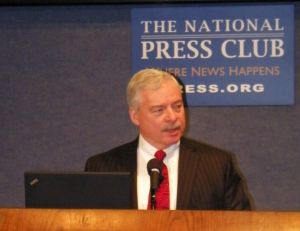The electrical power grid in the U.S. faces significant changes in technology over the next two decades, says a new report from the MIT Energy Initiative, but the grid also needs regulatory, economic, and security upgrades to meet these changes. The authors — 13 MIT faculty members plus one author from Harvard — discussed the report’s findings at a news conference today in Washington, D.C.
Richard Schmalensee (pictured left), professor of economics and management at MIT and study co-director, stressed that the nation’s electrical power grid is adequate to meeting today’s needs, calling the grid “old, but hardly archaic.” The report, however, says that the technology changes anticipated by the year 2030 present opportunities and challenges the U.S. needs to consider. “A failure to realize these opportunities or meet these challenges,” says the report, “could result in degraded reliability, significantly increased costs, and a failure to achieve several public policy goals.”
At the news conference, study co-director and electrical engineering professor John Kassakian, described some of the new technologies the grid can expect to see, covering physical transmission, distribution, and control. Phasor measurement units (PMUs), for example are sensors that measure a variety of variables affecting grid performance. A number of these PMUs are in operation across the eastern half of the U.S., which like radar, give a 360 degree view of grid operations, measuring everything all at once. The problem Kassakian noted, is at present we do not have the ability to capture, process, and get actionable information from this flood of data.
At the same time, the regulatory environment for the electrical grid, remains mired in the past. “The current regulatory framework, largely established in the 1930s,” says Schmalensee, “is mismatched to today’s grid.” Today’s regulations, he notes, are unprepared to support the new technologies and consumer services expected by the year 2030.
To enable a power grid capable of handling intermittent renewables such as solar and wind energy, says the report, the U.S. will need effective and enhanced federal authority over decisions on the routing of new interstate transmission lines. In cases where power is produced by solar or wind farms located far from where that power is to be used, requiring long-distance transmission lines to be built across multiple regulatory jurisdictions, the grid particularly needs this enhanced regulatory capability. The report recommends that the Federal Energy Regulatory Commission (FERC) either be given the authority to make decisions in such cases, or be designated as the “backstop” authority in cases where there are disputes.
The report also recommends revisions in the way customers pay for electric power. Payments for electric distribution and generation are now calculated based on usage. But most of the costs charged to customers are fixed, and do not depend on usage. This payment method, in effect, rewards utilities for resisting distributed generation, such as homeowners installing rooftop solar panels. This method also gives consumers excessive incentives to install such systems, and thus shift their share of fixed network costs to their neighbors. Fixed network costs, the reports says, should be recovered primarily through customer charges that don’t depend on electricity consumption.
Yet another emerging regulatory issue is security on a more accessible and interconnected grid. The report notes that no agency has responsibility and authority for security of the entire grid. The issue is complicated further by concerns over federalism, where federal authority would need to be imposed on the states that now have primary regulatory responsibility. Another concern is customer privacy, particularly when more high-performance metering systems get connected generating more detailed usage data than before.
Read more: NSF, Energy Dept to Fund Power Grid Research Center
* * *


 RSS - Posts
RSS - Posts
[…] Read more: Report: Electrical Grid Needs Technology, Regulatory Changes […]
[…] Read more. Report: Electrical Grid Needs Technology, Regulatory Changes […]
[…] Read more. Report: Electrical Grid Needs Technology, Regulatory Changes […]
[…] Read more: Report: Electrical Grid Needs Technology, Regulatory Changes […]